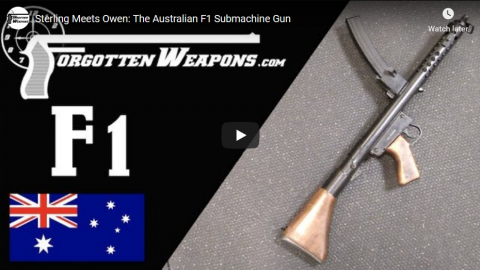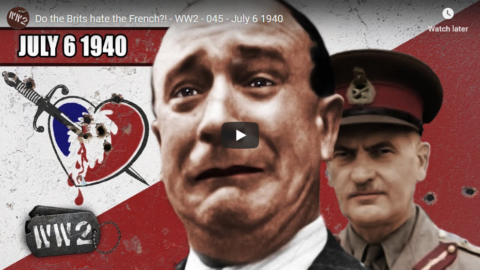Forgotten Weapons
Published 24 Jan 2020http://www.patreon.com/ForgottenWeapons
https://www.floatplane.com/channel/Fo…
Cool Forgotten Weapons merch! http://shop.bbtv.com/collections/forg…
During the 1930s, Sweden acquired an assortment of different submachine guns, including Bergmanns, Thompsons, and Suomis. As World War Two progressed, they decided that they really needed to standardize on a single caliber and model of gun, and requested designs from both the Carl Gustav factory and Husqvarna. The Carl Gustav design won out, and was adopted as the m/45.
It was a very simple open-bolt, tube-receiver, fixed-firing-pin design chambered for 9x19mm Parabellum ammunition. The original guns were built around Finnish Suomi magazines, both 71-round drums and 50-round “coffin” mags. After the war these were replace by a new 36-round traditional box magazine, and magazine well adapters were fitted to the guns which precluded the use of the larger mags. The new magazines were much more convenient to carry, less expensive, and more reliable.
The name “Swedish K” comes form the full designation: Kulsprutepistol m/45. The guns were used by American special operations forces in Vietnam until the Swedish government stopped export sales to the US, at which point the Navy commissioned Smith & Wesson to produce the Model 76 submachine gun (essentially a copy of the m/45). The design was also licensed by Egypt, which also licensed the AG-42 Ljungman rifle at the same time. The Egyptian copy was called the Port Said, and shows the features fo the original Swedish m/45 pattern, where the guns in Swedish service were mostly updated to the m/45B pattern.
Photo of m/45C with bayonet from: http://www.gotavapen.se/index_eng2g.htm
Check them out for a ton of information on Swedish small arms!
Contact:
Forgotten Weapons
6281 N. Oracle #36270
Tucson, AZ 85740
January 25, 2020
Swedish K: The Carl Gustav m/45B and the Port Said
January 3, 2020
M20 75mm Recoilless Rifle: When the Bazooka Just Won’t Cut It
Forgotten Weapons
Published 8 Mar 2018Sold for $6,325.
Note that this is a rewelded action. It should be inspected by a professional before being fired (the firing footage in the video is a different example).
The M20 75mm Recoilless Rifle was developed starting in 1944 as a replacement for the 3.5″ bazooka in an antitank role. It was developed and produced in parallel with a 57mm recoilless rifle (the M18), and both entered service in March of 1945, seeing just a slight bit of combat use before the end of World War Two. It would be a mainstay of US troops in the Korean War, however, along with a 105mm recoilless rifle. The M20 fired HE, HEAT, and WP (smoke) rounds, with the projectiles weighing 20-22 pounds (about 10kg) and having muzzle velocities of about 1000 fps (305 m/s). The shaped charge HEAT warhead could penetrate about 4″ (100mm) of armor, and had an effective range of about 400 yards. The HE warhead could be effectively used out to about 1000 yards, and the gun was equipped with both direct fire and indirect fire optical sights in order to effectively use both types of ammunition.
By the Vietnam War, the M20 was on its way out, as were recoilless rifles in general — they were being replaced with wire-guided missiles for antitank use. However, the M20 remains in service today for avalanche control in many Western states — a neat repurposing of obsolete weaponry!
http://www.patreon.com/ForgottenWeapons
Cool Forgotten Weapons merch! http://shop.bbtv.com/collections/forg…
If you enjoy Forgotten Weapons, check out its sister channel, InRangeTV! http://www.youtube.com/InRangeTVShow
November 20, 2019
Sterling Meets Owen: The Australian F1 Submachine Gun
Forgotten Weapons
Published on 20 Sep 2019http://www.patreon.com/ForgottenWeapons
Cool Forgotten Weapons merch! http://shop.bbtv.com/collections/forg…
The Australian Owen submachine gun was once of the best overall SMG designs of the Second World War, and when Australia decided to replace them in the 1960s, the new F1 design had big shoes to fill. The basic configuration of the top-mounted magazine remained, but coupled with elements of the Sterling SMG. The F1 used a simple sheet metal tube receiver with elements welded on, and a typical open bolt, blowback operating system. The unique rear system of separating the recoil spring from the main receiver body in the Owen was not included, instead using a basic open tube and large diameter mainspring. The sights are curiously still mounted to the right side of the gun, with a thin folding rear sight and a front sight affixed to the magazine well. These simplifications did have the effect of lightening the F1 compared to the Owen, which is a nice improvement. The F1 was manufactured from 1962 until 1973, with a total of about 25,000 made. It served in Vietnam and through the 1990s, when replaced by a variant of the F88 Austeyr. All reports are that it was a perfectly adequate submachine gun, but it did not earn the affection of troops like the Owen had.
Contact:
Forgotten Weapons
6281 N. Oracle #36270
Tucson, AZ 85704
September 29, 2019
An Axis of Evil is Complete – WW2 – 057 – September 28 1940
World War Two
Published 28 Sep 2019This week, the factions of World War Two begin to crystallise as the Japanese join the Axis powers.
Join us on Patreon: https://www.patreon.com/TimeGhostHistory
Or join The TimeGhost Army directly at: https://timeghost.tvFollow WW2 day by day on Instagram @World_war_two_realtime https://www.instagram.com/world_war_t…
Join our Discord Server: https://discord.gg/D6D2aYN.
Between 2 Wars: https://www.youtube.com/playlist?list…
Source list: http://bit.ly/WW2sourcesWritten and Hosted by: Indy Neidell
Produced and Directed by: Spartacus Olsson and Astrid Deinhard
Executive Producers: Bodo Rittenauer, Astrid Deinhard, Indy Neidell, Spartacus Olsson
Creative Producer: Joram Appel
Post-Production Director: Wieke Kapteijns
Research by: Indy Neidell
Edited by: Iryna Dulka
Map animations: EastoryColorisations by Norman Stewart and Julius Jääskeläinen https://www.facebook.com/JJcolorization/
Eastory’s channel: https://www.youtube.com/channel/UCEly…
Archive by Screenocean/Reuters https://www.screenocean.com.Sources:
– USHMM
1. Accession Number: 1992.252.1 | RG Number: RG-60.0621 | Film ID: 302
2. Photograph Number: 74565
– IMW:
IWM (A 1378)
IWM (A 1376)
IWM (CH 1429)
IWM (C 1819)TimeGhost chronological documentary produced by OnLion Entertainment GmbH.
September 6, 2019
QotD: The horrors of war
There’s no point in pretending that war isn’t horrible — flag-draped coffins are, in fact, a rather pristine symbol of those horrors. There’s a good reason societies honor their warriors.
An aside: I’ve long thought that prettifying World War II for domestic consumption contributed to both the media shock of Vietnam and the generation gap. WWII and Korea vets, who knew war first-hand, didn’t understand just how shocked their doted-on boomer kids were. “The Good War” wasn’t any more pleasant when you were experiencing it.
Virginia Postrel, “Horrors of War”, Dynamist.com, 2004-04-27.
August 31, 2019
History Summarized: French Empire (Ft. Armchair Historian!)
Overly Sarcastic Productions
Published on 30 Aug 2019Check out the Armchair Historian channel for more on French Vietnam and the battle of Dien Bien Phu: https://youtu.be/IJ051WyUsW8
Dubious morality, drawn out timescales, intricate royal politics, worldwide stages — Colonialism be like that sometimes. And by “Like That” I mean impenetrably complicated. I did my best, I’ll say that, but oh man is history a mess in the 15-1900s. This stuff is the reason I had so much trouble with history for so long. It’s just so DENSE.
ANYWAY, join Blue and Griffin the Armchair Historian for a look into the history of the multiple successive French Empires. Listen carefully as Blue makes imperceptibly subtle commentary about his extremely non-biased opinions on this chapter in history, and laugh together as we analyze the historical significance of Napoleon Bonaparte’s anime hair.
NOTE on 6:14 — I say Napoleon became Emperor in 1802. That’s a mistake. In 1802, the constitution of France was amended to make the position of Consul permanent, but Napoleon did not become the Emperor until 1804, when he declared the French Empire. That’s my bad.
NOTE on 11:25 — French Guiana, on the northeast coast of South America, remained part of France following the decolonization of Africa. That’s a mapping mix-up.
DISCORD: https://discord.gg/sS5K4R3
PATREON: https://www.Patreon.com/OSP
July 13, 2019
Local Boy Saves Nation: The Australian Owen SMG
Forgotten Weapons
Published on 8 May 2019Preorders now open for my book, Chassepot to FAMAS: French Military Rifles 1866-2016! Get your copy here: https://www.kickstarter.com/projects/…
http://www.patreon.com/ForgottenWeapons
Cool Forgotten Weapons merch! http://shop.bbtv.com/collections/forg…
The Owen submachine gun is one of the ugliest SMGs ever designed, and yet also one of the most beloved by its users. The original basis for the gun was a .22 rimfire submachine gun designed by 23-year-old Australian Evelyn Owen. That prototype was found by his neighbor Vincent Wardell after Owen left for military service. Wardell was the manager of Lysaght Works, an engineering firm, and thought that the gun might be the basis for a useful military SMG. As it turned out, he was right – it became the standard SMG of The Australian military through World War Two and the Korean War, and was one of the best such guns of that period. For more details on the history of the Owen, see my full article:
https://www.forgottenweapons.com/subm…
Thanks to Movie Armament Group in Toronto for giving me the opportunity to bring you this video! Check out MAG on Instagram: https://instagram.com/moviearmamentsg…
Contact:
Forgotten Weapons
PO Box 87647
Tucson, AZ 85754
July 7, 2019
Do the Brits hate the French?! – WW2 – 045 – July 6 1940
World War Two
Published on 6 Jul 2019The repercussions of the fall of France are not yet seen in full. But this week Britain makes it clear it isn’t about to give up, even if it will mean some really hard decisions.
Join us on Patreon: https://www.patreon.com/TimeGhostHistory
Or join The TimeGhost Army directly at: https://timeghost.tvFollow WW2 day by day on Instagram @World_war_two_realtime https://www.instagram.com/world_war_t…
Join our Discord Server: https://discord.gg/D6D2aYN.
Between 2 Wars: https://www.youtube.com/playlist?list…
Source list: http://bit.ly/WW2sourcesWritten and Hosted by: Indy Neidell
Produced and Directed by: Spartacus Olsson and Astrid Deinhard
Executive Producers: Bodo Rittenauer, Astrid Deinhard, Indy Neidell, Spartacus Olsson
Creative Producer: Joram Appel
Research by: Indy Neidell
Post production director: Wieke Kapteijns
Edited by: Iryna Dulka
Map animations: EastoryColorisations by Daniel Weiss, Norman Stewart and Julius Jääskeläinen https://www.facebook.com/JJcolorization/
Eastory’s channel: https://www.youtube.com/channel/UCEly…
Archive by Screenocean/Reuters https://www.screenocean.com.Sources:
WM: H 4610, A 3589
Narodowe Archiwum Cyfrowe
Jacques Mulard
Colorization of Göring by Klimbim
Romanian National ArchivesA TimeGhost chronological documentary produced by OnLion Entertainment GmbH.
June 4, 2019
Original Vietnam-Era M60 at the Range
Forgotten Weapons
Published on 27 Apr 2019http://www.patreon.com/ForgottenWeapons
Cool Forgotten Weapons merch! http://shop.bbtv.com/collections/forg…
The M60 was the first modern American military machine gun, developed from the operating system of the German FG-42 and the feed system of the German MG-42 in the years after World War Two. It has a rather schizophrenic reputation, being loved by many who used it in Vietnam and hated by many who used it later in its service life. The design had some fundamental flaws, but did offer a far more mobile base of fire than the M1919A6 that it replaced. Today, I am going to do a bit of shooting with an original Vietnam pattens M60, which will act as a baseline for future videos covering the various improvements and modernizations of the platform.
Thanks to the Institute of Military Technology (https://www.instmiltech.com) for giving me the opportunity to bring this M60 on camera for you!
Contact:
Forgotten Weapons
PO Box 87647
Tucson, AZ 85754
January 28, 2019
The Cold War – OverSimplified (Part 2)
OverSimplified
Published on 24 Jan 2019
January 21, 2019
M551 “Sheridan” AR/AAV | DESIGN DISASTER!
Matsimus
Published on 24 Dec 2018The M551 Sheridan was a light reconnaissance tank developed by the American company General Motors in May 1960 under the designation XM551. In November 1965 approval was given for the type classification of the XM551 as Limited Production and a four-year production contract was awarded to the Allison Motor Car Division of General Motors Corporation. In May 1966 the Sheridan was classified as Standard A and by this time production was well under way with the first production vehicle being completed in June 1966. Production continued until 1970 by when 1700 M551S (or General Sheridans) had been built, of which 1570 were still in service with the US Army in 1970. The role of the M551. as originally conceived, is to function as the main reconnaissance vehicle for armour, infantry and airborne operations and arms teams not employing main battle tanks. Late in 1978, it was announced that the M551 would be phased out of service and replaced by the M60A1 MBT, apart from those vehicles allocated to the 82nd Airborne Division (57) and Arkansas National Guard (12), 330 have been assigned to the National training Center at Fort Irwin, California. These are essentially basic M551s but with visual modifications to the outside to disguise them as “OPFOR force” vehicles such as BMP-1 and ZSU-23-4.
Hope you enjoy!!
Want to support my channel? Check out my Patreon Donation page! https://www.patreon.com/user?u=3081754
My PO Box: Matthew James 210A – 12A Street N Suite #135 Lethbridge Alberta Canada T1H2J
DISCORD: https://discord.gg/B7cbXgy
Twitter: https://twitter.com/MatsimusGaming
(DISCLAIMER: This video is for entertainment purposes only. The views and opinion come from personal experience or information from public accessible sources.)
January 2, 2019
Is the Stoner 63 Really So Good? Shooting the Mk23, Bren, and 63A Carbine
Forgotten Weapons
Published on 8 Dec 2018http://www.patreon.com/ForgottenWeapons
Is the Stoner 63 really as good of a gun as everyone says? Today is my first opportunity to try one out on the range, and I’m going to look at it in three different configurations: the Mk23 SEAL light machine gun, the “Bren” style automatic rifle, and the carbine. Let’s see how it handles!
I owe a tremendous thanks to Movie Armaments Group in Toronto for the opportunity to take the Stoner kit out to the range! Check them out on Instagram to see many of the guns in their extensive collection: https://instagram.com/moviearmamentsg…
Contact:
Forgotten Weapons
PO Box 87647
Tucson, AZ 85754
November 15, 2018
Colt Model 639: MACVSOG’s Vietnam Carbine
Forgotten Weapons
Published on 24 Oct 2018http://www.forgottenweapons.com/colt-…
http://www.patreon.com/ForgottenWeapons
The Colt Model 639 was the export version of the Colt Model 629, which was type classified by the US military as the XM177E2 and issued to MACVSOG special operations units in 1967 and 1968. Improved from the Model 609 carbine, the 629/639 has an 11.5 inch barrel and an interesting small muzzle device (“moderator”) which served to change the signature of its firing to sound much more like an AK-type rifle than an M16. The device does that job well – at least until it had been fired extensively, which slowly fills up the (non-disassemblable) unit with carbon and powder residue, substantially reducing its effectiveness. It has a full-fence lower, standard carbine buffer and spring, and a two position aluminum collapsing stock. It is the iconic weapon of US special forces in Vietnam.
Only about 100 of the Model 639 were made in the early 1970s, and many of those were sent back to Colt in 1975 under a recall. At that time, the ATF decided to classify the muzzle device as a silencer, prompting Colt to recall the guns and remove and destroy the devices. Some owners, however, kept their carbines and instead registered the muzzle devices, allowing them legally remain on the guns.
Contact:
Forgotten Weapons
PO Box 87647
Tucson, AZ 85754If you enjoy Forgotten Weapons, check out its sister channel, InRangeTV! http://www.youtube.com/InRangeTVShow
March 27, 2018
Metrics are merely a tool. Like any tool they can be misused.
A big problem with depending on metrics is finding things to count that are actually useful measurements of whatever you’re tracking. A lot of bad management decisions can be traced to poorly chosen metrics. As a general rule, just because something can be measured doesn’t automatically mean that measurement will be useful. Tim Harford reviews a recent book on metrics:
Jerry Z Muller’s latest book is 220 pages long, not including the front matter. The average chapter is 10.18 pages long and contains 17.76 endnotes. There are four cover endorsements and the book weighs 421 grammes. These numbers tell us nothing, of course. If you want to understand the strengths and weaknesses of The Tyranny of Metrics you will need to read it — or trust the opinion of someone who has.
Professor Muller’s argument is that we keep forgetting this obvious point. Rather than rely on the informed judgment of people familiar with the situation, we gather meaningless numbers at great cost. We then use them to guide our actions, predictably causing unintended damage.
A famous example is the obsession, during the Vietnam war, with the “body count” metric embraced by US defence secretary Robert McNamara. The more of the enemy you kill, reasoned McNamara, the closer you are to winning. This was always a dubious idea, but the body count quickly became an informal metric for ranking units and handing out promotions, and was therefore often exaggerated. Counting bodies became a risky military objective in itself.
This episode symbolises the mindless, fruitless drive to count things. But it also shows us why metrics are so often used: McNamara was trying to understand and control a distant situation using the skills of a generalist, not a general. Muller shows that metrics are often used as a substitute for relevant experience, by managers with generic rather than specific expertise.
Muller does not claim that metrics are always useless, but that we expect too much from them as a tool of management. For example, if a group of doctors collect and analyse data on clinical outcomes, they are likely to learn something together. If bonuses and promotions are tied to the numbers, the exercise will teach nobody anything and may end up killing patients. Several studies have found evidence of cardiac surgeons refusing to operate on the sickest patients for fear of lowering their reported success rates.
February 11, 2018
Sriracha Sauce and the Surprisingly Heartwarming Story Behind It
Today I Found Out
Published on 18 Jan 2018In this video:
The genesis of Sriracha hot sauce (pronounced sir-ah-cha, contrary to what many think) becoming the condiment staple it is today can be traced back to 1975 and an unassuming Vietnamese refuge called David Tran – the founder and current CEO of Huy Fong Foods.
Want the text version?: http://www.todayifoundout.com/index.p…











